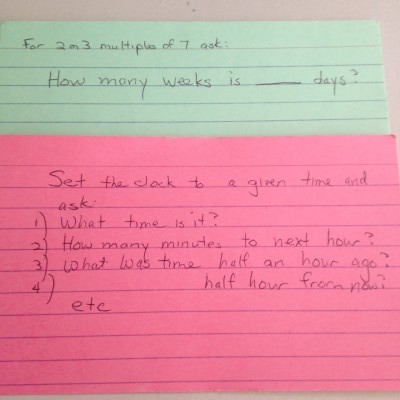Filling in the math gaps

by Kathy Kuhl
Make Your Own Math Review Cards for Systematic Refreshers
Ever noticed a topic is missing in your child’s math curriculum—or in your child’s general math knowledge? “What? He still doesn’t know days of the week?” “She has no clue how long an inch is.”
How do you fill in those gaps? Write a new math book? Add 16 more items to your to-do list?

There’s an easier way. Make personalized math review cards for each child who needs additional instruction. Write a short review activity on each card, one that takes only a minute or two to complete. Then do a few cards each day during your math time.
Often my cards are open-ended, so I don’t give the kids exactly the same problem each time.
Examples:
1. Here’s my card for practicing calendar skills:
Show me today’s date.
Show me ___ weeks from now. (Ask this twice with numbers 1-8).
Show me ___ weeks ago. (Ask this twice with numbers 1-8).
What was the date ___ days ago?
How many days until ____? (Pick a random date 7 to 70 days out, or an upcoming appointment, holiday, event, or birthday.)
2. The card below reviews facts about temperature scales. (You could argue this is science, not math.)
At sea level:
At what temperature Fahrenheit does water boil? Freeze?
At what temperature centigrade or Celsius does water boil? Freeze?
(For a middle schooler or high schooler you might include converting a temperature from Fahrenheit to centigrade or vice versa.)
3. You could make another skill card to review skip counting:
Skip count by _____. (Do this three times. Mom-teacher picks three numbers 2 to 10)
For this we skip-counted to 100 and back (or 121 or 144 if you skip count by elevens or twelves).
But the best part is we march around the house as we count. We take tiny steps for small numbers and huge steps for large numbers. We walk backwards when we count backwards.
Notice that these activities get us up and around the house. Movement helps kids learn.
If you complete three or four cards each school day, your child will get regular review in these areas of need.
But how do I know what to put on the cards, asks one parent. That depends on what’s missing from your math curriculum.
From where I sit, I can’t tell you, any more than I can tell you what’s now missing from your desk or shoulder bag. Next time, I’ll discuss how to find the gaps.
What tools do you use to fill in gaps in your child’s math knowledge?



One Comment